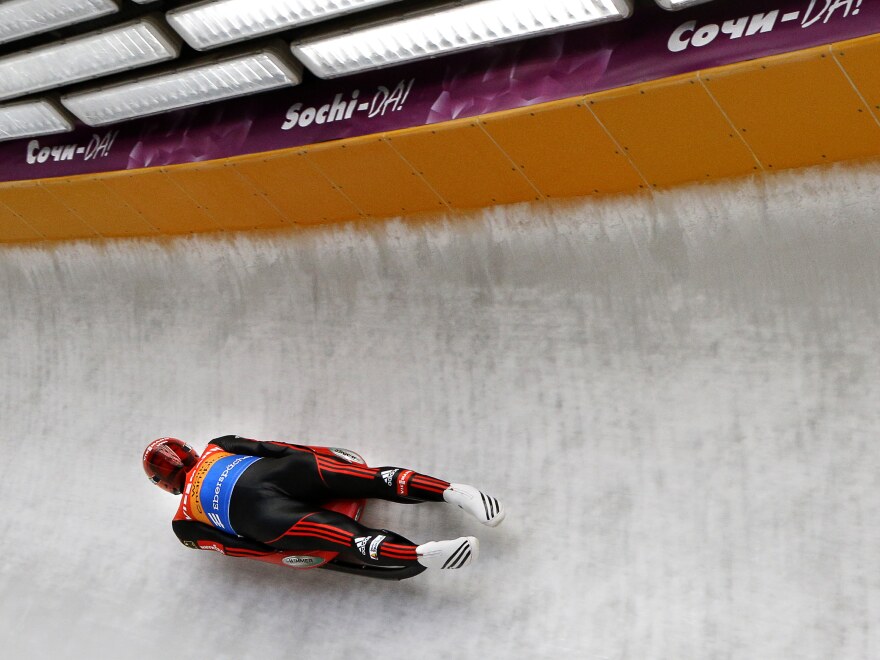With bobsled, luge and skeleton racers rocketing down a winding, ice-covered track, sled racing will be one of the most exciting events at the Winter Olympics next month in Sochi, Russia.
The first thing you have to know about sled racing is that it's a little like NASCAR: It's all about speed. And the tracks, built all over the world — including the new one in Sochi — are really different, according to Steve Holcomb, who won a gold medal in four-man bobsled four years ago.
"They all kind of have their own personalities," Holcomb says. "Each engineer is different, puts their own, like, mentality and mindset into designing it."
That track on a mountainside in Whistler, British Columbia, for the 2010 Vancouver Olympics was designed to revolutionize the sport, making it more aggressive, boosting top speeds from around 85 mph to more than 95 mph. But Holcomb, who's also captain of the U.S. team, says the track at Sochi will be very different, featuring a design that's extremely rare among sliding track sports: It slows the sleds down in some places.

Why not build the fastest track possible? The change goes back to the 2010 Vancouver games. Justin Olsen, who was on Holcomb's team, says every run was about survival.
"Hold onto something, bite your teeth, close your eyes, do something — we're either going to make it or we're not," Olsen says. "Most tracks, you go through the most difficult portions early on. Vancouver, just, you know, it just never lets up."
John Morgan, a former bobsledder who now works as a sled racing analyst for sports networks, says that high-octane X-Games edge was by design.
"Canadians wanted to build the biggest, baddest, fastest track ever — and they did," Morgan says.
Sled racing is inherently risky, Morgan points out. His own brother died in a bobsled accident in Italy in the early '80s. But the track in Vancouver sparked horror and controversy when a young luge racer from the Republic of Georgia crashed on a training run and was killed. NPR's Howard Berkes reported:
"First-time Olympian Nodar Kumaritashvili was rocketing out of the last curve on the Olympic luge track at close to 90 mph, feet first and face up, when his sled slid into a sidewall. The Georgian athlete was launched directly into a steel pillar and collapsed like a rag doll — arms, legs and head limp."
Morgan says there's agreement now that for all but the top athletes, Vancouver's track was too aggressive.
"It's a great track for the elite top 10, 15 athletes in each discipline," Morgan says. "But it was too much for the ... what I call second-level athlete that qualifies into the Olympic Games."
Before Kumaritashvili's death, Sochi organizers were planning for a track where bobsleds could top 100 mph. Holcomb says that escalation — that international one-upmanship — was quickly scrapped.
So now the Sochi track has an extremely rare design for sliding-sport tracks: uphill sections. Most tracks don't have a single elevation increase along their course; Sochi has three. It's so unique that American sledders worry it could give a huge home-track advantage to the Russians, who've had more time to practice on the course and perfect their runs.
Viewers won't see as many wrecks, or the same kind of breakneck speed, says Olsen. Instead, they'll see sled drivers navigating incredibly complex twists and turns, which Holcomb says could make the viewing experience a little different.
"They actually had to change the design a little bit and put in three uphill sections to slow the sled down. Not good for the spectators, probably," says Holcomb. "They like the crashes."
Copyright 2021 NCPR. To see more, visit NCPR. 9(MDAxNzg0MDExMDEyMTYyMjc1MDE3NGVmMw004))






